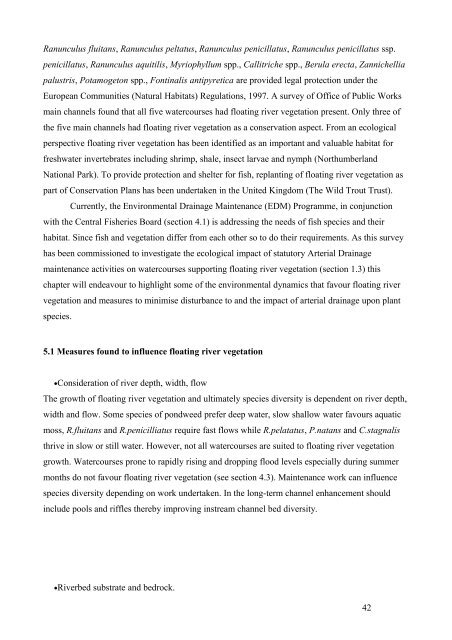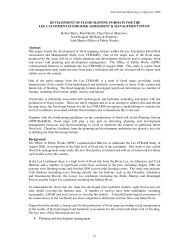Vegetation (Floating River Vegetation) - Office of Public Works
Vegetation (Floating River Vegetation) - Office of Public Works
Vegetation (Floating River Vegetation) - Office of Public Works
Create successful ePaper yourself
Turn your PDF publications into a flip-book with our unique Google optimized e-Paper software.
Ranunculus fluitans, Ranunculus peltatus, Ranunculus penicillatus, Ranunculus penicillatus ssp.<br />
penicillatus, Ranunculus aquitilis, Myriophyllum spp., Callitriche spp., Berula erecta, Zannichellia<br />
palustris, Potamogeton spp., Fontinalis antipyretica are provided legal protection under the<br />
European Communities (Natural Habitats) Regulations, 1997. A survey <strong>of</strong> <strong>Office</strong> <strong>of</strong> <strong>Public</strong> <strong>Works</strong><br />
main channels found that all five watercourses had floating river vegetation present. Only three <strong>of</strong><br />
the five main channels had floating river vegetation as a conservation aspect. From an ecological<br />
perspective floating river vegetation has been identified as an important and valuable habitat for<br />
freshwater invertebrates including shrimp, shale, insect larvae and nymph (Northumberland<br />
National Park). To provide protection and shelter for fish, replanting <strong>of</strong> floating river vegetation as<br />
part <strong>of</strong> Conservation Plans has been undertaken in the United Kingdom (The Wild Trout Trust).<br />
Currently, the Environmental Drainage Maintenance (EDM) Programme, in conjunction<br />
with the Central Fisheries Board (section 4.1) is addressing the needs <strong>of</strong> fish species and their<br />
habitat. Since fish and vegetation differ from each other so to do their requirements. As this survey<br />
has been commissioned to investigate the ecological impact <strong>of</strong> statutory Arterial Drainage<br />
maintenance activities on watercourses supporting floating river vegetation (section 1.3) this<br />
chapter will endeavour to highlight some <strong>of</strong> the environmental dynamics that favour floating river<br />
vegetation and measures to minimise disturbance to and the impact <strong>of</strong> arterial drainage upon plant<br />
species.<br />
5.1 Measures found to influence floating river vegetation<br />
•Consideration <strong>of</strong> river depth, width, flow<br />
The growth <strong>of</strong> floating river vegetation and ultimately species diversity is dependent on river depth,<br />
width and flow. Some species <strong>of</strong> pondweed prefer deep water, slow shallow water favours aquatic<br />
moss, R.fluitans and R.penicilliatus require fast flows while R.pelatatus, P.natans and C.stagnalis<br />
thrive in slow or still water. However, not all watercourses are suited to floating river vegetation<br />
growth. Watercourses prone to rapidly rising and dropping flood levels especially during summer<br />
months do not favour floating river vegetation (see section 4.3). Maintenance work can influence<br />
species diversity depending on work undertaken. In the long-term channel enhancement should<br />
include pools and riffles thereby improving instream channel bed diversity.<br />
•<strong>River</strong>bed substrate and bedrock.<br />
42

















